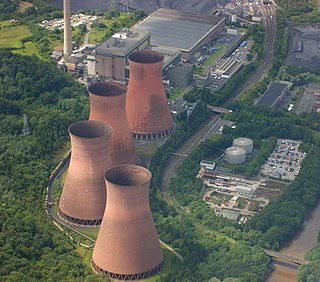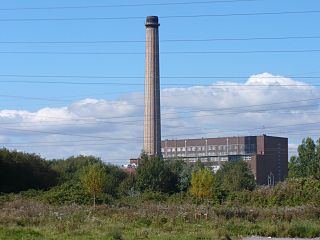
Drax power station is a large biomass power station in Drax, North Yorkshire, England. It has a 2.6 GW capacity for biomass and had a 1.29 GW capacity for coal that was retired in 2021. Its name comes from the nearby village of Drax. It is situated on the River Ouse between Selby and Goole. Its generating capacity of 3,906 megawatts (MW), which includes the shut down coal units, is the highest of any power station in the United Kingdom, providing about 6% of the United Kingdom's electricity supply.

A fossil fuel power station is a thermal power station which burns a fossil fuel, such as coal, oil, or natural gas, to produce electricity. Fossil fuel power stations have machinery to convert the heat energy of combustion into mechanical energy, which then operates an electrical generator. The prime mover may be a steam turbine, a gas turbine or, in small plants, a reciprocating gas engine. All plants use the energy extracted from the expansion of a hot gas, either steam or combustion gases. Although different energy conversion methods exist, all thermal power station conversion methods have their efficiency limited by the Carnot efficiency and therefore produce waste heat.

The Ironbridge power stations refers to two power stations that occupied a site on the banks of the River Severn at Buildwas in Shropshire, England. The Ironbridge B Power Station was operated by E.ON UK but the site is now owned by Haworth Group. The station stands near the Ironbridge Gorge World Heritage Site. Originally powered by coal, they were converted to use 100% biomass fuel. Ironbridge B Power Station stopped generating electricity on 20 November 2015, with the decommissioning process continuing into 2017. The main phase of the 27-month demolition process began at 11:00 GMT on 6 December 2019, commencing with the four cooling towers.

Atikokan is a town in the Rainy River District in Northwestern Ontario, Canada. The population was 2,642 as of the 2021 census. The town is one of the main entry points into Quetico Provincial Park and promotes itself as the "Canoeing Capital of Canada". Atikokan was originally established as a Divisional Point for the Canadian Northern Railway.

The Nanticoke Generating Station was a coal-fired power station in Nanticoke, Ontario in operation from 1972 to 2013. It was the largest coal power station in North America and, at full capacity, it could provide 3,964 MW of power into the southern Ontario power grid from its base in Nanticoke, Ontario, Canada, and provided as much as 15% of Ontario's electricity.

Rentech, Inc. was a Los Angeles, California–based company that owned and operated wood fiber processing and nitrogen fertilizer manufacturing businesses. It provided wood chipping and wood pellet services through a subsidiary Fulghum Fibres, Inc. and sold nitrogen fertilizer through Rentech Nitrogen Partners, L.P. In addition, Rentech owned the intellectual property for a number of energy technologies, such as Rentech–SilvaGas Gasification Process and Fischer–Tropsch process based Rentech Process.

Drax Group plc, trading as Drax, is a power generation business. The principal downstream enterprises are based in the UK and include Drax Power Limited, which runs the biomass fuelled Drax power station, near Selby in North Yorkshire. The Group also runs an international biomass supply chain business. The company is listed on the London Stock Exchange and is a constituent of the FTSE 250 Index.
The energy policy of India is to increase the locally produced energy in India and reduce energy poverty, with more focus on developing alternative sources of energy, particularly nuclear, solar and wind energy. Net energy import dependency was 40.9% in 2021-22. The primary energy consumption in India grew by 13.3% in FY2022-23 and is the third biggest with 6% global share after China and USA. The total primary energy consumption from coal, crude oil, natural gas, nuclear energy, hydroelectricity and renewable power is 809.2 Mtoe in the calendar year 2018. In 2018, India's net imports are nearly 205.3 million tons of crude oil and its products, 26.3 Mtoe of LNG and 141.7 Mtoe coal totaling to 373.3 Mtoe of primary energy which is equal to 46.13% of total primary energy consumption. India is largely dependent on fossil fuel imports to meet its energy demands – by 2030, India's dependence on energy imports is expected to exceed 53% of the country's total energy consumption.
The electricity policy of Ontario refers to plans, legislation, incentives, guidelines, and policy processes put in place by the Government of the Province of Ontario, Canada, to address issues of electricity production, distribution, and consumption. Policymaking in the electricity sector involves economic, social, and environmental considerations. Ontario's electricity supply outlook is projected to deteriorate in the near future due to increasing demand, aging electricity supply infrastructure, and political commitments, particularly the phase-out of coal-fired generation. Policymakers are presented with a range of policy choices in addressing the situation, both in terms of overall system design and structure, and specific electricity generating technologies.
Atikokan Generating Station is a biomass power plant owned by Ontario Power Generation (OPG) located 8 km (5 mi) north of Atikokan, Ontario. The plant employs 90 people. The Atikokan Generating Station began operation as a coal fired station in 1985 and underwent an overhaul in the autumn of 2003.

Ontario Power Generation Inc. (OPG) is a Crown corporation and "government business enterprise" that is responsible for approximately half of the electricity generation in the province of Ontario, Canada. It is wholly owned by the government of Ontario. Sources of electricity include nuclear, hydroelectric, wind, gas and biomass. Although Ontario has an open electricity market, the provincial government, as OPG's sole shareholder, regulates the price the company receives for its electricity to be less than the market average, in an attempt to stabilize prices. Since 1 April 2008, the company's rates have been regulated by the Ontario Energy Board.
According to the International Hydropower Association, Canada is the fourth largest producer of hydroelectricity in the world in 2021 after the United States, Brazil, and China. In 2019, Canada produced 632.2 TWh of electricity with 60% of energy coming from Hydroelectric and Tidal Energy Sources).
Coal reserves in Canada rank 13th largest in the world at approximately 10 billion tons, 0.6% of the world total. This represents more energy than all of the oil and gas in the country combined. The coal industry generates CDN$5 billion annually. Most of Canada's coal mining occurs in the West of the country. British Columbia operates 9 coal mines, Alberta nine, Saskatchewan three and New Brunswick one. Nova Scotia operates several small-scale mines, Westray having closed following the 1992 disaster there.

The Tilbury power stations were two thermal power stations on the north bank of the River Thames at Tilbury in Essex. The 360 MW dual coal- and oil-fired Tilbury A Power Station operated from 1956 until 1981 when it was mothballed, prior to demolition in 1999. The 1,428 MW Tilbury B Power Station operated between 1968 and 2013 and was fueled by coal, as well as co-firing with oil and, from 2011, biomass. Tilbury B was demolished in 2016–19. Since 2013 three other power stations have been proposed or constructed in Tilbury.

The Uskmouth power stations refers to a series of two coal-fired power stations at the mouth of the River Usk in the south-east of Newport, Wales. The first of the two station, Uskmouth A power station, was built in the 1940s and demolished in 2002.

Renewable energy in Canada represented 17.3% of the Total Energy Supply (TES) in 2020, following natural gas at 39.1% and oil at 32.7% of the TES.

The Lambton Generating Station was a coal-fuelled power plant located on the St. Clair River near Corunna, Ontario, delivering up to 950 MW of power to the grid. It is owned by Ontario Power Generation.
Denmark is a leading country in renewable energy production and usage. Renewable energy sources collectively produced 81% of Denmark's electricity generation in 2022, and are expected to provide 100% of national electric power production from 2030. Including energy use in the heating/cooling and transport sectors, Denmark is expected to reach 100% renewable energy in 2050, up from the 34% recorded in 2021.
The Nanticoke Solar Facility is a 44 MW solar power station in Nanticoke, Ontario, Canada. It is located on the site of the defunct Nanticoke Generating Station, which operated from 1972 to 2013 and was the largest coal-fired power plant in North America.














